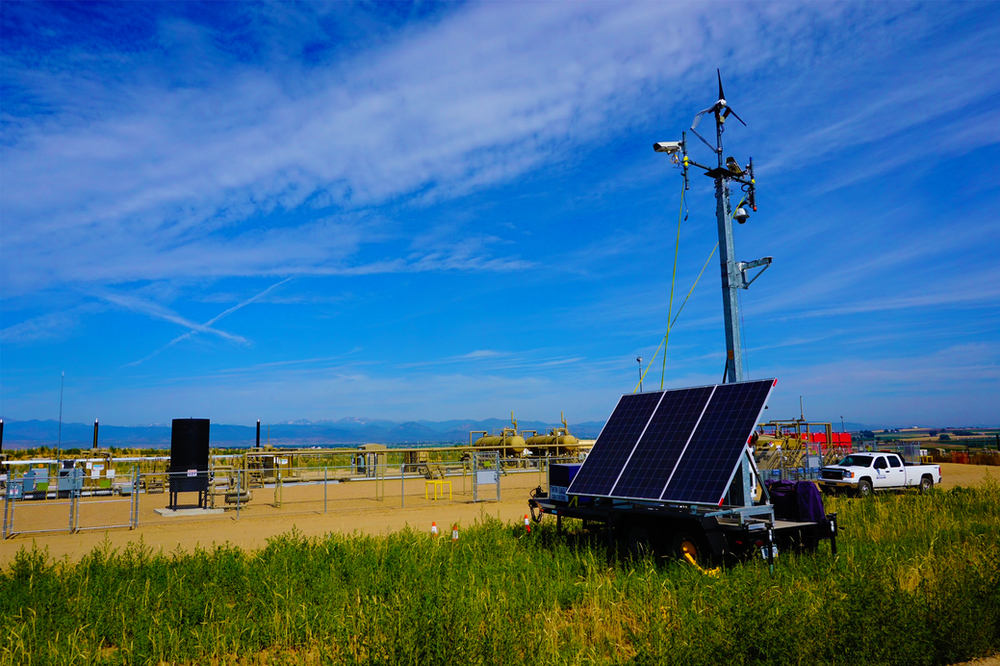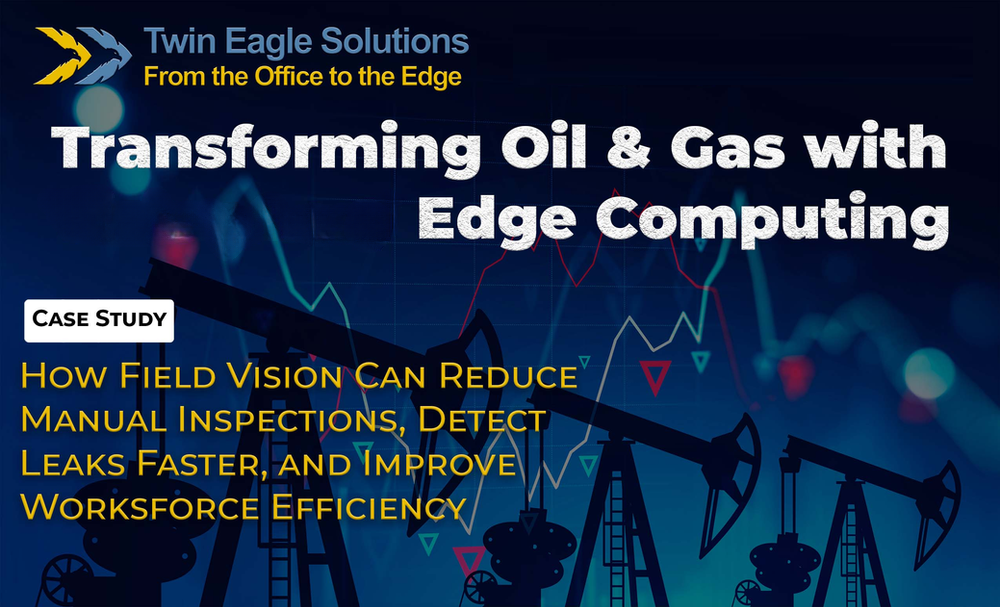
INTRODUCTION
The oil and gas industry (O&G) has not historically been known for its innovation. However, in light of economic, environmental, and political shifts, many O&G companies are actively exploring ways to be more proactive, operate more efficiently, reduce waste, and simplify compliance. This white paper explores how Field Vision, an innovative solution architected by Twin Eagle Solutions, is modernizing the industry, and helping O&G customers achieve those goals. It also briefly discusses relevant applications in other industries.
WHAT IS FIELD VISION
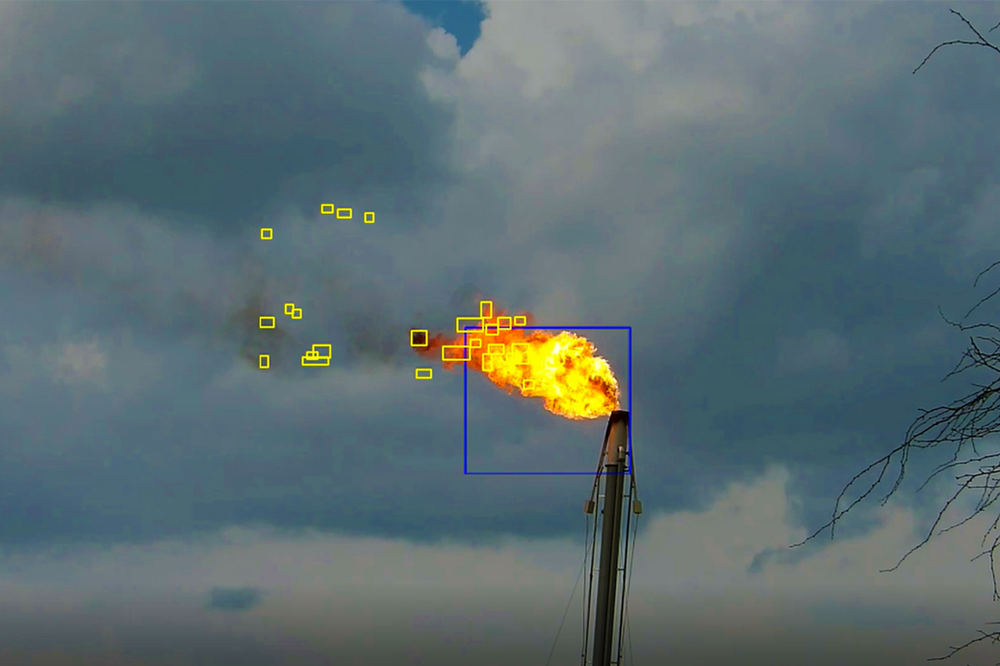
Field Vision is a set of tools and technologies that can be programmed to perform any visual inspection or monitoring functions on remote sites. Artificial intelligence, machine learning, and advanced analytics allow Field Vision to not only capture events but to learn patterns, detect inconsistencies or anomalies, and proactively trigger alerts or actions in response to those events. Field Vision is at the forefront of the Industrial Internet of Things (IIoT), utilizing edge technology to link central and remote sites to improve efficiency, productivity, reliability, and safety.
Specific real-world applications of Industrial IoT Field Vision solutions include Remote Site Inspection (Remote Vision), Fire Watch (Thermal Vision), Thermal and Radiometric Imaging (Thermal Vision), Flare and Smoke Inspections (Intelligent Vision), and Intelligent Monitoring (Intelligent Vision).
EMPOWERING THE DIGITAL OILFIELD
Twin Eagle Solutions was contacted by a midstream transportation solutions provider who was looking to manage remote operations and inspections at multiple sites more efficiently. Midstream providers are responsible for transportation of oil, and leaks in the pipeline can be very costly in terms of product waste and state and/or federal agency fines associated with leaks.
This midstream provider maintains the highest level of safety protocols for its operations. Corporate policy dictates that every site must be inspected every day. With multiple, far flung sites and limited workforce bandwidth, “every site, every day” became challenging and expensive. Limitations included:
– Long drive times between sites
– Workforce capacity to reach and inspect all sites during the work week
– Unplanned but necessary maintenance of sites further reduced capacity
With only manual processes in place, the company was inspecting ~70% of their sites during the regular work week and 30-40% of their sites on the weekend. This left significant room for error in terms of undetected leaks. In addition to product loss, the company was subject to significant penalties, which are typically calculated from the time of last inspection to the time the leak is repaired. The environmental and financial costs of an undetected leak can be significant.
In O&G, time is, in fact, money, so a new solution was required to achieve the following goals:
– Real-time leak detection
– Decreased response and repair times
– Improved regulatory compliance
– Reduced fines and other penalties
– Improved employee efficiency
– 100% site inspection rate
A LEADING EDGE SOLUTION
To solve this problem, Twin Eagle Solutions Deployed its Industrial IoT Field Vision Solution, a leading-edge IIoT solution that utilizes machine learning and advanced camera analytics. Field Vision uses one of three technologies to create benefits for the end user. The three technologies are Remote Vision, Thermal Vision, and Intelligent Vision.
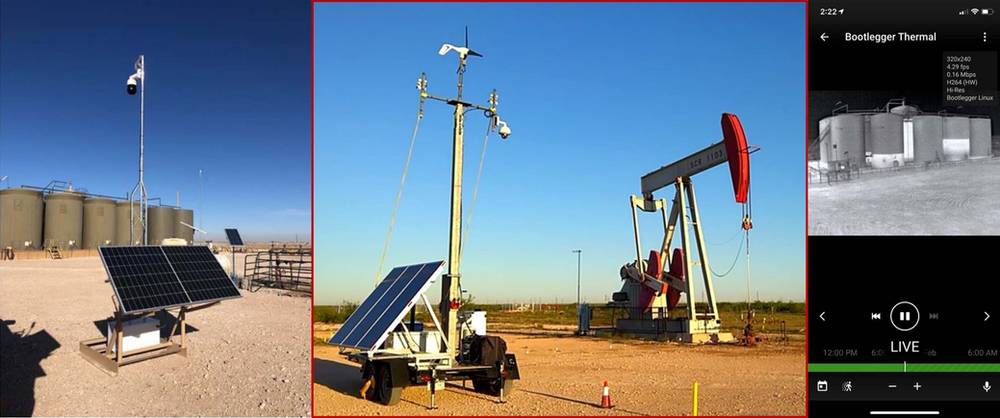
Remote Vision – is the cost effective solution that allows end user to remotely view their assets and only visit the sites that need maintenance.
Thermal Vision – gives the end user the ability to autonomously monitor material build up and temperature in and on their assets.
Intelligent Vision – gives the end user the ability to train a camera on what to look for and develop reporting around those metrics. Common examples are liquid and gas leak detections.
Field Vision can be programmed with a set of rules that will identify if an item, such as a suitcase, remains static for a set period of time. This is known as “dwell time.” If an unknown item exceeds the dwell time rules, an alert can be automatically sent to have the scene inspected. Field Vision can also learn environmental patterns, like shadows as the earth moves around the sun, to eliminate false positives. It can detect patterns for human activity and alert if persons enter unauthorized areas.
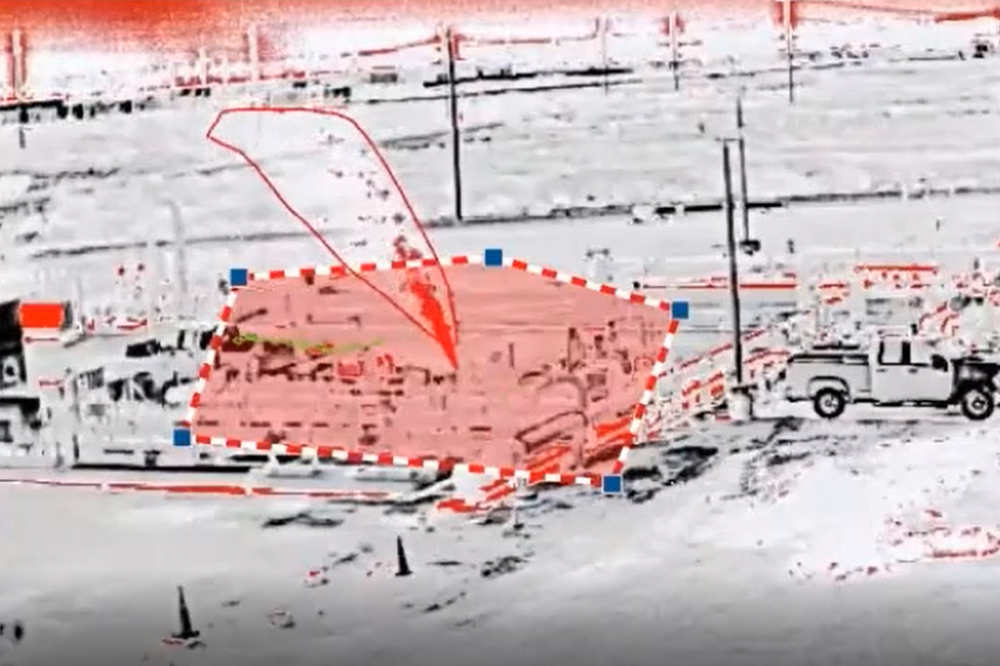
Field Vision can detect any elemental changes to a scene and trigger responses based on a set of user-defined rules. Essentially, it is always asking: “Is there something there that shouldn’t be there? Is there something there that wasn’t there before?” As the environment or scene changes over time, the camera learns and adapts. While other cameras have similar capabilities, these cameras tend to have rule sets based on active motion-based alerting. An example would be detecting that a vehicle entered a restricted oilfield at 2 a.m., and established rules dictate that no vehicles should be on premise after 8 p.m.. This would trigger an alert and response.
Field Vision is unique in that it can also detect smaller, slower changes over time. The Field Vision Camera learns that the ground at an oilfield is white sand. It learns the shadow patterns throughout the day and how they shift seasonally. Based on rules, it can also eliminate scene changes caused by weather, such as rain or wind. As it tracks and learns the scene, it can also detect and alert that there is gradual and widening darkening of sand due to a frack water or oil leak.
Alerts can be sent in a number of ways. If an anomaly is detected, the system can send an email that includes a snapshot of the scene. It can send an alert to an alarm panel that can dial out to a central station or remote operations center. Or it can transmit an alarm digitally or virtually to another system that is then programmed to respond according to a defined set of rules. The camera alert can also be piped into a central operations monitoring facility that tracks various metrics for all field operations. In all cases, the alerts happen nearly instantaneously once a “fault” condition has been detected. This is critically important when every second counts as pertains to safety, security, and product integrity.
Shown below is an image of an actual leak detection scenario. In this situation, the set delay period for identifying and alerting on a leak is five seconds. This photo depicts the pump area with a possible leak. The monitored area is colored green, indicating no present issues; the area of possible concern has been identified by the IVA in red.
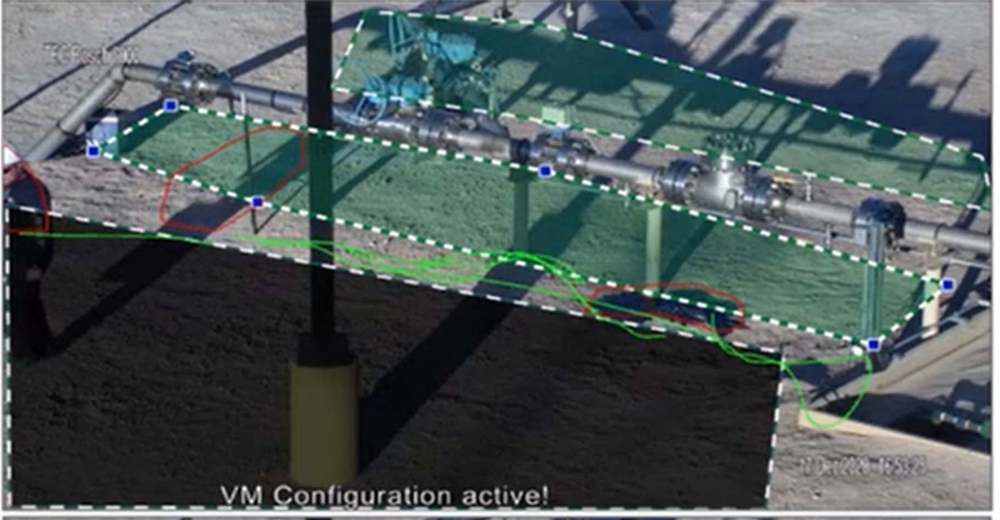
This next photo was taken after the five second delay elapsed. The color change of the area to red indicates an alarm state, and appropriate alerts were sent to personnel to respond to the problem area.
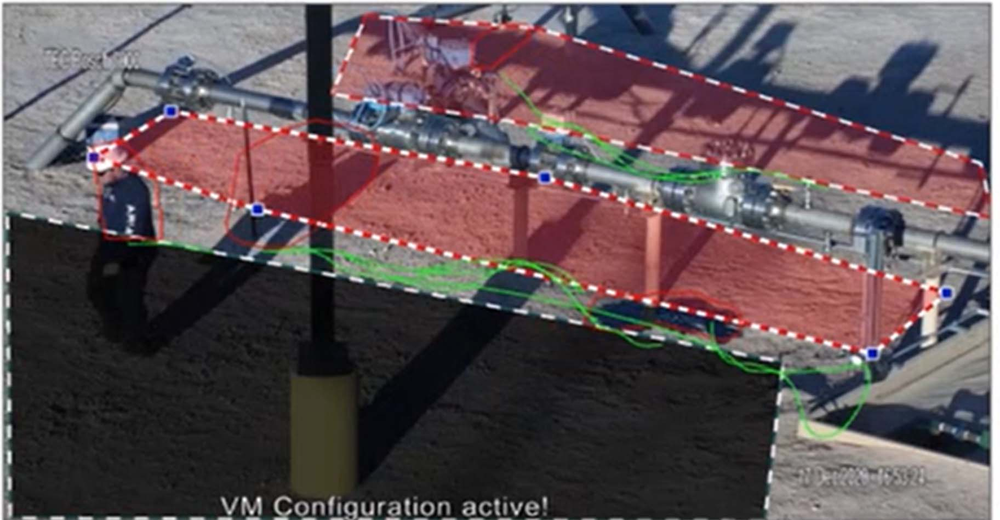
In this case, the Field Vision solution was able to learn normal conditions for the monitored area; discount acceptable variants, such as weather and shadowing (none of which shown triggered an alert); detect, tag, and alert of gradual changes in ground color that could be an active leak.
Beyond leak detection, Industrial IoT Field Vision technology can also quickly detect variants to defined rule sets. Some examples include:
– Absence of Personal Protection Equipment (PPE) – Corporate policies and state and/or federal guidelines often dictate that employees must wear PPE, like a hard hat, when entering job sites. If any employee enters the site without a hard hat, an alert via text, email, or other means can be sent to relevant personnel to rectify the situation.
– Flare and Smoke Monitoring – With new EPA regulation on flares and black smoke, the requirements for flare monitoring is more important and harder to do then ever. Flare and Smoke Vision can monitor flares for anomalies and detect black smoke.
– Unauthorized vehicle types – If typical traffic to a work site includes only trucks of various sizes, the presence of a Volkswagen Beetle would be detected by the Field Vision solution. It could then send an alert to security personnel to investigate.
– Unauthorized license plates – Many work sites require license plate registration of authorized vehicles. If a vehicle with an unrecognized plate number enters the site, security can be quickly alerted to respond.
– Unauthorized persons – If there are areas of a facility or work site where people are prohibited, alerts, including a snapshot, can be sent to security if a person enters that area.
In essence, VisoinAery, using the Field Vision suite of solutions, can learn to identify and track any number of conditions that a company might want to monitor. It seamlessly bridges the gap between corporate and field operations and allows companies to operate more efficiently and profitably.
These industrial grade intelligent security cameras are built to withstand the rigors of any edge-based application while offering state-of-the-art video capability, machine learning, and advanced analytics. Field Vision cameras are built on an open platform that allows customers to customize and augment the cameras’ capabilities with third party apps.
GAINING THE COMPETITIVE EDGE
Field Vision is and will continue to be a key priority for companies that want to survive and thrive in a changing, potentially turbulent, landscape. As companies – regulated and unregulated – look to Field Vision as a way to streamline operations and optimize workforce efficiency, numerous benefits can be achieved, including:
– Real-time detection and alerts based on user-defined rules
– Significantly improved response times to alerts
– Optimization of personnel to allow them to focus on more complex tasks
– Automation of time-intensive manual tasks, like gauge readings
– Increased accuracy of remote field gauge readings
– 100% site coverage, 24 hours a day, 7 days a week
– Ability to remotely manage field safety and security, e.g., PPE, authorizations, etc.
– Simpler regulatory compliance
– Reduction in regulatory penalties and/or fines
– Predictive maintenance of field equipment via audio/video remote monitoring
– Streamlined communications between corporate and field operations
– Faster, deeper insights into field operations
– Reduction of environmental impact due to early issue detection and repair
– Decreased carbon footprint due to elimination of unnecessary truck runs
– Remote startup and shutdown of facilities reduces risk of fire, explosion, and employee injury
OIL AND GAS GOES GREEN: POTECTING THE ENVIRONMENT
The O&G industry has made significant strides in lessening impact on the environment in recent years, and Industrial IoT can help them expand those efforts. By implementing Field Vision for all of its facilities, the midstream solutions provider was able to decrease site visits in fossil fuel consuming vehicles by 70-80%.
As a result, they were able to reduce carbon emission by approximately 4,480 pounds per month for every truck in the fleet that had previously been performing daily truck runs. As more O&G companies expand their use of Field Vision, they can achieve significant industry-wide reductions in carbon emissions and help preserve the environment for future generations.
APPLICATIONS BEYOND OIL AND GAS
While this paper explored an Remote Vision project at a midstream produced water solutions provider, Field Vision has numerous applications for other industries, including:
– Refineries that must monitor combustible components and industrial grade machinery can do so remotely.
– Nuclear Power Providers can respond faster to any detected issues or anomalies, utilize predictive maintenance to keep equipment in peak operating form, and minimize risk of fire and/or explosion during its most critical periods – plant startup and shutdown.
– Shipyards that store ships with hybrid motors (electric motors using natural gas or hydrogen) using volatile materials that must be closely monitored remotely to minimize risk of fire and/or explosion.
– Foodservice, Medical, and Marine Industries which require stainless steel housing and pure aluminum construction on all components in working areas can use OA to monitor operations, industrial machinery, and safety and compliance with all statutory and regulatory requirements.
SET UP YOUR DEMO
Industrial IoT is available for demo using Twin Eagle’s Mobile Applications Platform.
